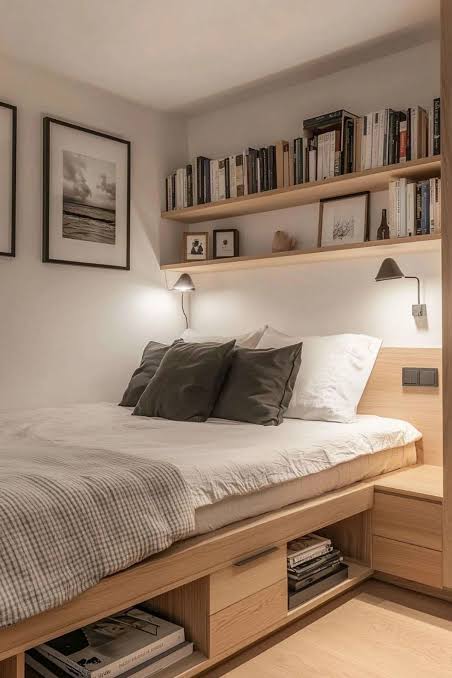How to Decorate a Small Room: Tips for Maximizing Space and Style

Decorating a small room can feel like a challenge, but with the right strategies, you can transform it into a stylish, functional, and cozy space. Whether it’s a compact bedroom, a tiny living area, or a multi-purpose home office, these practical tips will help you make the most of your limited square footage without sacrificing aesthetics.
1. Embrace Light Colors and Strategic Lighting
Light colors make a room feel larger and more open. Opt for soft hues like whites, pastels, or light grays for walls, furniture, and decor. To enhance the effect:
Use mirrors to reflect light and create the illusion of depth. A large mirror opposite a window can double the perceived space.
Incorporate layered lighting: Combine overhead lights, wall sconces, and table lamps to brighten corners and add warmth. Avoid heavy fixtures that overwhelm the space.
Choose sheer curtains or skip window treatments altogether to let natural light flood in.
Pro Tip: Consider an accent wall with a bold color or wallpaper to add personality without shrinking the room visually.
2. Prioritize Multi-Functional Furniture
In a small room, every piece of furniture needs to earn its place. Look for items that serve multiple purposes:
Storage beds with drawers or lift-up frames are perfect for stashing linens or clothes.
Foldable desks or wall-mounted tables can double as workspaces or dining areas.
Ottomans with hidden storage can act as seating, a footrest, or a coffee table.
Sofa beds are ideal for guest-ready spaces without sacrificing daily comfort.
Pro Tip: Choose furniture with exposed legs to create a sense of openness, as it allows light to flow underneath.
3. Maximize Vertical Space
When floor space is limited, think upward:
Install floating shelves to display decor, books, or plants without cluttering the floor.
Use tall, narrow storage units like bookcases or cabinets to keep items organized while drawing the eye upward.
Hang wall hooks or racks for bags, hats, or accessories to free up drawer space.
Pro Tip: A tall, slim ladder shelf adds both storage and a decorative touch without taking up much floor space.
4. Keep Clutter at Bay
A cluttered room feels smaller, so organization is key:
Declutter ruthlessly: Keep only essentials and items that spark joy. Donate or store anything unnecessary.
Use baskets or boxes to corral small items like cables, magazines, or toys.
Incorporate hidden storage: Think under-bed bins, behind-door organizers, or furniture with built-in compartments.
Pro Tip: Adopt a “one in, one out” rule to prevent future clutter buildup.
5. Choose the Right Scale for Furniture and Decor
Oversized furniture can overwhelm a small room, so scale matters:
Opt for slim-profile pieces: A sleek sofa or a narrow console table fits better than bulky alternatives.
Use small-scale decor: Instead of one large piece of art, try a gallery wall with smaller frames to add interest without dominating the space.
Incorporate glass or acrylic furniture: Transparent pieces like a clear coffee table or chairs visually disappear, keeping the room airy.
Pro Tip: Measure your space carefully before buying furniture to ensure it fits comfortably with room to move.
6. Create Zones for Multi-Purpose Rooms
If your small room serves multiple functions (e.g., a bedroom-office combo), define distinct zones:
Use rugs to visually separate areas, like a workspace from a sleeping area.
Position furniture strategically: A bookshelf can act as a room divider without blocking light.
Incorporate portable solutions: A rolling cart can serve as a mobile desk or bar that tucks away when not in use.
Pro Tip: A folding screen can add privacy or hide a work area while doubling as a decorative element.
7. Add Personal Touches Thoughtfully
Personalizing a small room is important, but avoid overcrowding:
Choose a few meaningful accents: A vibrant throw pillow, a textured blanket, or a unique lamp can add character without clutter.
Incorporate plants: Small potted plants or hanging greenery bring life and color without taking up much space.
Rotate decor seasonally: Swap out accessories like cushions or artwork to keep the space fresh without permanent clutter.
Pro Tip: Use command hooks to hang lightweight decor, making it easy to change things up without damaging walls.
8. Optimize Layout for Flow
A well-planned layout can make a small room feel more spacious:
Keep pathways clear: Arrange furniture to allow easy movement, ideally with 2-3 feet of walking space.
Push furniture against walls: In tight spaces, this can free up the center of the room.
Experiment with angles: Sometimes, placing furniture at an angle can create a dynamic flow and make the room feel less boxy.
Pro Tip: Sketch your layout on paper or use a free online room planner to test ideas before moving heavy furniture.
Final Thoughts
Decorating a small room is all about balance—maximizing function while maintaining style. By choosing multi-purpose furniture, embracing light colors, and keeping clutter under control, you can create a space that feels open, inviting, and uniquely yours. Start with one or two tips from this list, and watch your small room transform into a big statement.
Have a small room you’re decorating? Share your challenges or ideas in the comments below, and let’s spark some inspiration!

























Comments
This post currently has no comments.